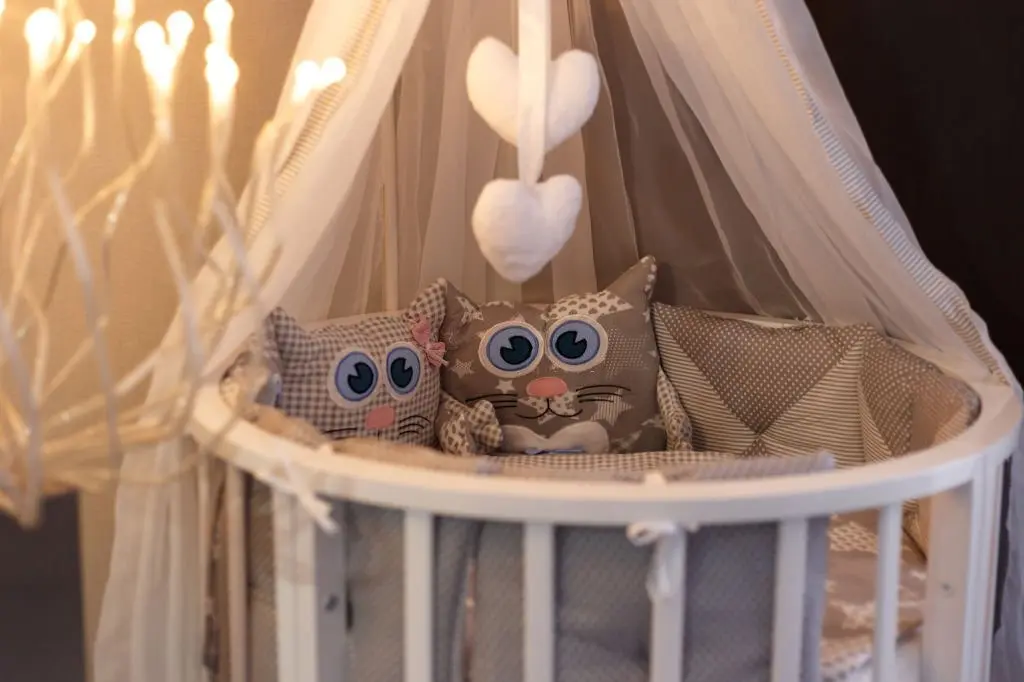At What Age Are Crib Bumper Pads Safe?

Introduction: At what age are crib bumper pads safe?
Crib bumper pads are a popular nursery accessory thought to provide comfort and safety for babies in their cribs. For many years, bumpers were considered standard items on a parent’s registry checklist. However, emerging research over the past decade reveals that bumpers may do more harm than good when it comes to infant safety.
At what age are crib bumper pads safe? In today’s article, we will take a comprehensive look at the risks and benefits of crib bumpers to help you make an informed decision for your family. We will explore what experts say about different types of bumpers, recommended age guidelines, and alternative ways to keep your baby safe and secure in the crib if you choose to skip the bumpers.
There is no one-size-fits-all approach to crib safety, so our goal is to provide the facts and guidance to help you determine what is right for your unique situation. The health and well-being of babies are the top priority, so let’s examine if crib bumpers support that important goal or contradict it.
What are crib bumper pads?

Crib bumper pads are cushioned fabric coverings that tie onto the slats of a crib. They are intended to protect babies from injuries by covering the hard edges of the crib and preventing limbs from getting stuck between the slats.
Traditional crib bumpers surround all 4 sides of the crib from corner to corner. However, mesh crib liners and vertical bumpers that only cover the crib slats have emerged as alternatives in response to safety concerns.
At what age are crib bumper pads safe?
Experts say that traditional crib bumpers aren’t recommended for infants due to the risk of suffocation. The American Academy of Pediatrics (AAP) and the Consumer Product Safety Commission (CPSC) both advise against their use. But why? Let’s dive deeper.
Understanding the risks of crib bumpers
- Suffocation: The soft material of traditional crib bumpers can pose a suffocation risk if the baby’s face gets pressed against it.
- Strangulation: Pads that tie to the crib slats can become loose and pose a strangulation hazard.
- Getting Stuck: There’s a risk of arms and legs getting stuck between the slats of the crib if the bumper pad isn’t securely fastened.
The data speaks: Infant deaths and injuries
A study concluded that crib bumpers are associated with 282 injuries and 107 baby deaths over a certain period. These baby deaths associated with crib bumpers were mainly due to suffocation.
What do the experts say?
The American Academy of Pediatrics (AAP) and the Consumer Product Safety Commission (CPSC) both have guidelines on safe sleep for babies. They recommend:
- Avoiding the use of crib bumpers of any kind for infants.
- Use a fitted sheet on the mattress.
- Keeping the crib or bassinet free from toys, pillows, and heavy bedding.
- Safe Sleep Guidelines
- Place in a Safe Sleep Environment: Ensure your baby sleeps on a firm mattress covered by a fitted sheet.
- Positioning: Always put your baby to sleep on their back.
- Avoid Overcrowding: Keep soft objects, toys, and loose bedding out of the baby’s crib.
Are there safe alternatives to traditional crib bumpers?
Absolutely! If you’re concerned about your baby’s arms or legs getting stuck in the crib slats, consider these alternatives:
Mesh Crib Liners: These are breathable and reduce the risk of suffocation. They snugly fit the sides of a crib and allow for better airflow.
Vertical Crib Liners: These wrap around each individual crib slat, ensuring no gaps for little arms and legs to get stuck.
Why mesh crib bumpers might be a better choice
Mesh crib bumpers, or mesh liners, are made of breathable mesh material. They:
- Allow for better airflow.
- Reduce the risk of SIDS (Sudden Infant Death Syndrome).
- Are snug against the inside of the crib, reducing the risk of entrapment.
Tips for safe sleep without crib bumpers
Here are some tips for keeping your baby safe in their crib without using bumpers:
- Use a tight-fitting crib sheet and avoid all soft bedding, blankets, pillows, and toys in the baby’s sleep area.
- Dress your baby in a wearable blanket instead of a loose blanket.
- Lower the mattress as your baby grows. Make sure no more than two finger widths fit between the mattress and crib sides.
- Place the crib away from windows and cords.
- Use a mesh play yard for naps if concerned about limbs getting stuck in slats.
- Once sitting, switch to a low toddler bed so climbing isn’t a risk.
- Redirect your baby from chewing on crib slats with safe toys.
Conclusion: At what age are crib bumper pads safe
Parenting comes with its fair share of worries, and ensuring a safe sleep environment for your baby tops the list. While crib bumper pads might seem like a good idea initially, the risks associated with them can’t be ignored. Always prioritize safety over aesthetics. After all, nothing beats the peace of mind you get from knowing your little one is safe and sound.
Also Read:
- Are Cribs Safe Without Bumpers?
- How to Prevent Baby from Getting Legs Stuck in Crib
- What To Look For When Buying a Crib
- Are Iron Cribs Safe for Babies
FAQs: At what age are crib bumper pads safe
Do crib bumpers prevent SIDS?
No, crib bumpers do not prevent SIDS (Sudden Infant Death Syndrome). In fact, crib bumpers may increase a baby’s risk of SIDS. The Consumer Product Safety Commission found over 100 infant deaths linked to crib bumpers over a 14-year period.
Most deaths occurred when babies suffocated after becoming trapped between a bumper and another object. Crib bumpers also pose a strangulation risk from cords or ties.
According to the American Academy of Pediatrics, a tight-fitting crib sheet is the only safe bedding needed to prevent SIDS. Crib bumpers are unnecessary and dangerous in a baby’s sleep environment.
Are breathable mesh crib liners safe?
Mesh or breathable crib liners are not considered safe by pediatricians and safety experts. While mesh liners seem like a safer alternative to traditional padded bumpers, there is no evidence confirming they reduce the risk of injury or death.
Babies’ limbs can still potentially get trapped in the openings of the mesh. And mesh liners that attach to crib slats violate the American Academy of Pediatrics safe sleep guidelines to avoid any objects in the crib.
Because mesh liners remain unregulated, there are no safety standards and testing specific to these products. For now, it’s best to avoid mesh liners until more research establishes their safety. A fitted crib sheet is the only bedding recommended for safe infant sleep.
Do crib bumpers prevent arm and leg injuries?
Parents often use crib bumpers believing they prevent arm and leg injuries from a baby’s limbs getting stuck in the crib slats. However, the risk of serious injury or death from crib bumpers outweighs any potential benefits.
Over 100 infant deaths have been associated with crib bumpers when babies’ faces became trapped against bumper padding. There are also risks of strangulation from bumper ties and cords. Preventing limbs from getting stuck can be better accomplished by lowering the mattress as your baby grows.
Make sure no more than 2 finger widths fit between the mattress and crib side. Also, dress the baby in footed pajamas to avoid leg entanglements. While injuries can happen, they are typically minor and manageable without crib bumpers.
At what age can you use crib bumpers?
The American Academy of Pediatrics cautions against using infant crib bumpers but doesn’t provide exact age guidelines. Some pediatricians recommend waiting until at least 2 years old before considering bumper use when children can climb in and out of a crib independently.
However, risks may remain since shoulder width expands as toddlers grow which raises concern about body parts getting trapped behind bumpers. To be safe, it’s best to transition your child to a toddler bed and avoid crib bumpers altogether.
If choosing to use crib bumpers once your child is a toddler, select a mesh style without padding for the least risks. Continue monitoring closely and remove immediately if any safety issues arise.
Are crib bumpers safe for toddlers?
Once children reach toddler age around 2-3 years old, the risk of using crib bumpers decreases but is not eliminated entirely. The greatest suffocation and strangulation dangers are avoided as toddlers gain mobility to reposition themselves and avoid getting trapped.
However, other hazards remain. Toddlers’ wider shoulders can still potentially get stuck behind bumpers. Bumpers also make it harder to supervise your child while sleeping.
Transitioning to a toddler bed rather than using crib bumpers is the safest option. If crib bumpers are used for toddlers, choose breathable mesh without padding and avoid ties or cords.
Continue to monitor closely and remove immediately if safety issues arise. Many pediatricians still recommend no bumpers until a child fully transitions to a “big kid” bed around ages 3-4.
What’s the best way to keep limbs in the crib?
To keep your baby’s limbs safely in their crib, follow these tips:
1. Use a snug-fitting sleep sack or wearable blanket and avoid loose blankets.
2. Dress your baby in footed pajamas with fitted legs and arms.
3. Make sure the mattress fits snugly against all sides of the crib. Leave no more than two finger widths of space.
4. Lower the mattress as your baby grows to prevent limb entrapment.
5. Redirect your baby from chewing on crib slats with safe teethers.
6. For naps, use a mesh “Pack ‘n Play” play yard if concerned about sticking limbs through slats.
7. Avoid crib bumpers which have risks of entrapment, strangulation, and suffocation.
8. Transition to a toddler bed once standing to allow your child to get in and out safely.
With safe sleep practices, there is no need for crib bumpers or mesh liners to keep your baby’s arms and legs safely inside the crib. Simple steps like fitted-footed pajamas and lowering the mattress work best!fitted-footed
